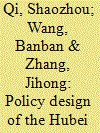|
|
|
Sort Order |
|
|
|
Items / Page
|
|
|
|
|
|
|
| Srl | Item |
| 1 |
ID:
136190


|
|
|
|
|
| Summary/Abstract |
Of seven pilot emissions trading schemes (ETS) being run in China, the ETS in Hubei province is the only provincial pilot in the central and western regions of the country with a high GDP growth rate and heavy industrial structure. As such, it is quite representative of China as a whole and its ETS will therefore be reasonably characteristic of a future nationwide market. This paper describes the policy design of the Hubei ETS, including aspects of coverage, cap, allowance allocation, transactions, compliance and penalties. Then, after making a comparison with the other Chinese pilots and emissions trading schemes in the European Union (EU) and California, the paper offers a summary of several distinct features of the Hubei ETS. First, the small numbers of entities that are covered by the scheme produce a considerable proportion of the emissions. This makes Hubei the world׳s third largest carbon market. Second, the Hubei ETS applies several mechanisms to deal with the province’s rapid growth rate. Third, the scheme׳s policy design emphasizes liquidity. In addition to these unique features, the Hubei ETS also shares some common features with all the pilots in China.
|
|
|
|
|
|
|
|
|
|
|
|
|
|
|
|
| 2 |
ID:
192383


|
|
|
|
|
| Summary/Abstract |
This unique study focuses on how the carbon trading system (CTS), stakeholder concerns and innovation incentive policies all combine to effect enterprises' green technology innovation. Using a three-dimension system, this study includes green output level, green output proportion and green total factor productivity. Utilizing a DID model of an unbalanced panel, we investigate how government and enterprise work together better to achieve carbon emission targets. The main findings are as follows: (1) Enterprises are displaying a high level of concern with environmental information disclosure and therefore their CTS will have a more significant impact on green technology output and the proportion of this green output. In contrast, government concerns about decarbonization with CTS have uncertain effects on the three dimensions of green technology innovation. (2) CTS Fiscal subsidies and R&D funding are strong ways to improve enterprises' green technology output. However, the best way to improve green technology output, green output proportion and green total factor productivity is with tax returns. When tax returns increase 1%, the green output level increases 1.5% under the CTS. (3) This study, utilizing data from the impact of different implementation modes of innovations incentive policies, shows that inclusive innovation policies make CTS's combined effects more significant than differentiated policies.
|
|
|
|
|
|
|
|
|
|
|
|
|
|
|
|
|
|
|
|
|